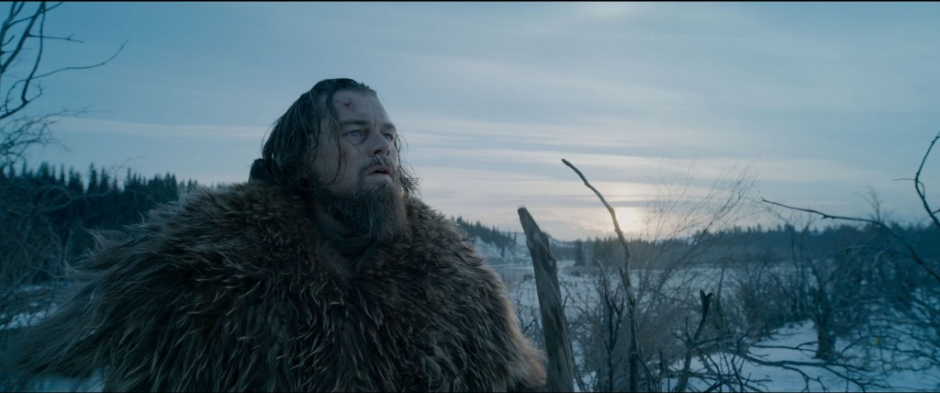When you went to see a film at The Cornerhouse you could feel secure in the fact that it had already received an important seal of approval. The Cornerhouse didn’t just show any film. It had to be considered a little bit special, and a little bit different, to make it onto the silver screen. Despite the end of that well-loved cinema, and its merging with The Library Theatre to create the bigger (and quite possibly better) HOME, that tradition has continued. HOME may show a few more films than its predecessor did, but you can bet that the selection process is equally as discerning.
So when you see a film that could arguably be called a blockbuster on the list of showing times, it’s fair to assume that there’s going to be something that sets it apart from the standard Hollywood fare. That is certainly the case with The Revenant. It features two of Tinseltown’s biggest money makers: Leonardo di Caprio and Tom Hardy. And it gives a post-Harry Potter and Star Wars role to Domhnall Gleeson (earmarking perhaps, a star of the future). But that is pretty much where the Hollywood clichés end.
The Revenant is a film that does things few others would dare to: from the way it’s shot, to the intensity of the violence, to the genuine ability to shock the audience out of any kind of stupor, this is a film that dares to be different and does different with aplomb.
This uniqueness is marked in a very early sequence: a battle scene filmed like no other before it. Director Alejandro G. Inarritu puts down a marker here, informing the audience that they’re about to see a film that isn’t afraid of getting up close and personal and has no issues with making its audience squirm. The camera is so close to the faces and bodies of the victims of this battle that you almost feel every arrow that enters them and sense every shotgun that explodes by their ears. And on that note, whether it is down to the direction of the film or the outstanding speakers at HOME, there can rarely have been a better use of surround sound than in this scene and the film as a whole. You will feel submerged at its very centre.
By the time this battle comes to its bloody end, we have already received the first big shock of the film. From then on they come thick and fast. Hugh Glass (di Caprio) is at this film’s heart, so you could be forgiven for expecting that he will lead his team out of the dangerous situation they have found themselves in, or at least go down while valiantly fighting for this cause. So when he is almost killed by a bear before their escape is even properly underway, there can few who aren’t taken aback by this turn of events. And that surprise is only added to by the way this scene is presented. Watching Glass being dragged about and mauled by a grizzly becomes incredibly captivating because of the unflinching way in which it is filmed. Of all the outstanding passages in the movie, this might be the one that will live longest in the memory.
The following three quarters of an hour or so gives Tom Hardy (who has currently been behind the cinematography, the scenery, and di Caprio in terms of the film’s most impressive elements) the opportunity to come to the fore. His character John Fitzgerald is clearly the villain of the piece, and in Hardy’s list of villainous portrayals this latest one makes Batman’s Bane pale into insignificance. After agreeing to stay behind and look after the miraculously alive but stretcher bound Glass, we see Fitzgerald soon tire of this caring role and try to bring things to a quicker resolution. When Glass’s son tries to prevent this from happening, a brawl erupts and the young combatant is killed while his father watches from his stretcher.
And this scene, despite all the brilliance that has come before it, is where the real crux of the film lies. Because from this point on we’re treated to one of the most powerful filmic portrayals of a father’s love for his children that you are ever likely to see. Glass’s determination to recover from his wounds to wreak his revenge on Fitzgerald leads to one of the most intensely realised displays of emotion in contemporary cinema. And along the way we’re treated to a mix of beautiful cinematography, jaw-droppingly exciting action, and a whole host of award worthy performances.
And on that note, although we may have mentioned di Caprio, Hardy, and Gleeson as indicators of Hollywood convention at the top of this review, that is not to say that any of their performances are conventional. Or anything less than stellar, in fact. And the same should be said about Will Poulter, Forest Goodluck, and Duane Howard. Without these first rate performances the force of this film would be unrealisable, and each of them deserves a nod come award season.
All of this combined puts The Revenant up there with the very best. Some reviews have already called it the film of the year, and you might think that January is a little early to make such a statement. But when a film is as good as this, good enough maybe to make it onto lists that look at films of all time and not just films of the last twelve months, it is difficult to see what might surpass it.
Fran Slater

